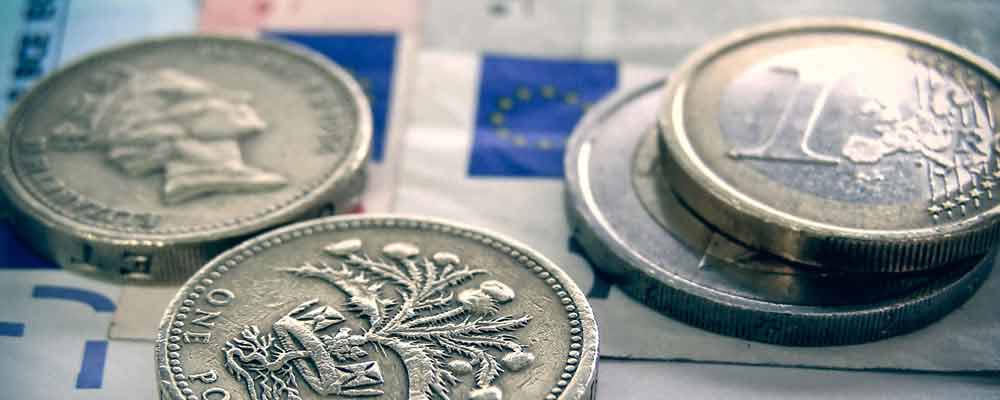The Euro Pound Exchange Rate (EUR/GBP) exchange rate declined on Monday following the release of a better-than-forecast UK Services PMI report, but the common currency resisted further losses as the week continued and the Eurozone published a string of mixed ecostats.
- Euro Pound weakened by lacklustre data – Spanish unemployment and Italian GDP weigh on EUR
- GBP exchange rates boosted by PMI – Construction index for August just misses growth territory
- US jobs disappointment enables Pound gains – GBP in limbo until US data published
- EUR GBP forecast – ECB rate decision to weigh on exchange rates
Pound Weakens on Profit-Taking; Poor German Data Prevents Strong Euro Gains
The Euro has so far been unable to taken advantage of the Pound’s weakness today due to further poor data from Germany. Industrial production figures are the latest ecostats to soften the outlook for the Eurozone economy, with many wondering if the currency bloc’s former powerhouse has now turned into its anchor, holding back progress despite growth in other member states. Production dropped -1.5% on the previous month and -1.2% on an annualised basis. Forecasts had been for a strong slowing in growth, but for expansion to continue marginally.
(Last updated 09.00, 07/09/2016)
Pound Shrugs Off Worst UK Retail Sales Data Since April
The latest British Retail Consortium sales figures have unexpectedly shown a decline. Predicted to accelerate from 1.1% to 1.4% in August, sales instead contracted -0.9%. However, the Olympics and sunny weather were cited as the main reasons for the decline, rather than Brexit-related uncertainty.
BRC Chief Helen Dickinson commented; ‘Care should be taken in reading too much into August’s lacklustre performance. The fact is that, so far, little has directly changed for the UK’s consumers as a result of the referendum.’
The Pound is struggling to hold on to gains, however, after the latest Eurozone retail PMIs. The indices all markedly improved, with the Eurozone index climbing far enough to re-enter growth territory. Italy’s retail sector remained the worst performing, with a 2.9 point increase still leaving the index at 43.2, well into contraction territory. Meanwhile, low impact government spending figures, as well as household consumption data, indicate that inflationary pressures are likely to remain weak in the Eurozone.
(Previously updated 11.23, 06/09/2016)
UK Brexit Fears Ease, Euro Pound Exchange Rate Falls Today
The Euro Pound exchange rate fell to a low of 0.8350 on Monday as investors responded to another sign that the UK economy is faring better-than-expected in the wake of the UK’s decision to Brexit from the European Union in June.
The UK’s Services PMI printed at 52.9 in August, well above the 50 line separating growth from contraction and outstripping forecasts.
Markit economist Chris Williamson noted; ‘A record rise in the services PMI adds to the encouraging news seen in the manufacturing and construction sectors in August to suggest that an imminent recession will be avoided. The three PMI surveys point to a stagnation of the economy so far in the third quarter, meaning much hinges on the September data to see whether the economy contracts or ekes out modest growth.’
However, the Pound’s gains quickly began to soften. With the PMIs last week significantly overshooting forecasts, markets were already anticipating a strong showing from today’s index, meaning investors had largely priced in the result.
News from the Eurozone, meanwhile, weighed on demand for Euro (EUR) exchange rates, with Germany publishing worse-than-expected Services and Composite PMIs. These results left the composite PMI for the Eurozone as a whole trailing the forecast 53.3 figure at 52.9.
These results may encourage European Central Bank (ECB) chief Mario Draghi to adopt a dovish tone following this week’s policy meeting. Any hints at a future expansion of stimulus measures is likely to keep the Euro (EUR) pressured and drive the currency lower vs rivals like the Pound and US Dollar.
However, other Eurozone data was more encouraging, with the Eurozone Sentix Investor Confidence Index advancing from 4.2 to 5.6 and retail sales increasing by 1.1% on the month rather than the 0.5% forecast by economists.
Annually, retail sales were up 2.9% – a significant improvement on June’s year-on-year retail sales figure of 1.7%.
(Previously updated 08:00 GMT 05/09/2016)
Despite a strong recovery towards growth for the UK construction sector, the EUR GBP exchange rate only slumped after the release of poor US labour market data.
Pound Sterling had to wait for its chance to go bullish on Friday, with markets slow to react to the construction PMI until US data had been released.
EUR GBP Advances before UK Services PMI; Eurozone PMIs Incoming
After the success of last week’s manufacturing and construction PMIs, markets are eagerly awaiting the index for the UK’s key services sector. Manufacturing unexpectedly bounded into growth territory, rising to a ten-month high, while the construction index posted a much smaller contraction than forecast, coming within a single point of neutral territory. Forecasts are for the services PMI to rise from 47.4 to 50, showing that the industry stagnated, but considering the over-performance of the other indices, expectations are for a significantly more bullish result.
(Last updated 08.45, 05/09/2016)
Euro to Pound (EUR GBP) Exchange Rate Tumbles after US Data Disappoints
It was a quiet data day for the Eurozone on Friday. What data there was available was largely poor, kicking off with the Spanish unemployment change posting a 14.4k increase in the number of jobless. A significant -49.7k drop had been forecast after July’s -84k decline. Later, Italian GDP figures came in on or around forecast to show the economy stagnated in the second quarter.
It was the day’s US data that really tipped the Euro into decline. The headline non-farm payrolls report did nothing to boost hopes of a rate hike in 2016 from the Federal Reserve, while unemployment remained unchanged and wage growth weakened further-than-expected.
This weakened the Euro because a stronger US Dollar, caused by an interest rate hike, would be highly advantageous for the Eurozone. The inverse correlation between EUR and USD would see the Euro pressured lower as the US Dollar advanced, aiding the European Central Bank (ECB) in their quest to boost Eurozone inflation. Lowering the purchasing power of the Euro has been a long-term goal for the ECB and, with suggestions that its choice of remaining policy tools is becoming limited, an external event weakening the common currency would prevent the Governing Council from having to unleash yet more easing measures.
Strong UK Construction PMI Fails to Inspire another Bullish Pound Sterling Rally

While many had been looking to Friday’s Markit construction PMI to repeat the performance of Thursday’s manufacturing data, the above-forecast rise in the index was met with indifference to begin with. While the manufacturing PMI’s rise from 48.3 to 53.3 had triggered a bullish charge for the Pound, Friday’s climb in construction activity from 45.9 to 49.2 initially failed to move the Pound.
Markit Senior Economist Tim Moore commented that;
‘The downturn in UK construction activity has eased considerably since July, primarily helped by a much slower decline in commercial building. Construction firms cited a nascent recovery in client confidence since the EU referendum result and a relatively steady flow of invitations to tender in August.’
However, he also noted that the sector remained in a far from rosy state, claiming;
‘The latest survey indicates only a partial move towards stabilisation, rather than a return to business as usual across the construction sector. There were still widespread reports that Brexit uncertainty had dampened demand and slowed progress on planned developments, especially in relation to large projects. As a result, total new order volumes continued to fall during August, which stands in contrast to the three-year run of sustained growth seen prior to May 2016.’
The Pound Euro (GBP EUR) exchange rate spent much of the day trending only marginally higher, although the move away from opening levels had been made prior to the release of the date and remained unchanged after the construction figures were released. This only changed once the US data had been released, after which the Pound made a bullish advance.
Euro Pound (EUR GBP) Forecast; UK Services and ECB Policy Meeting to Drive Exchange Rate Movement
The key UK services PMI is set for release today. With the manufacturing and construction indices both drastically outperforming expectations, there is a strong chance that the PMI will rise above the forecast score of 50 and into growth territory. Such a result would send the Pound on a bullish uptrend thanks to the improved outlook for the UK economy and a weakening case for further monetary stimulus measures from the Bank of England (BoE).
Meanwhile for the Eurozone the week’s most important development will be the latest monetary policy meeting for the European Central Bank (ECB). The general market consensus is that there will be no changes made to interest rates, but that the Governing Council may make some adjustments to the parameters of the quantitative easing programme. This is because the supply of eligible Eurozone bonds is currently shrinking due to the increased demand from the ECB. While a change in the rules for bond purchases would be more impactful upon treasury yields than on the Euro, the common currency could still be moved by comments on the outlook of future monetary policy.
EUR, GBP Conversion Rates
Towards the end of Friday’s European session the Euro Pound (EUR GBP) exchange rate trended around 0.8390, while the Pound Euro (GBP EUR) exchange rate trended in the region of 1.1917.



